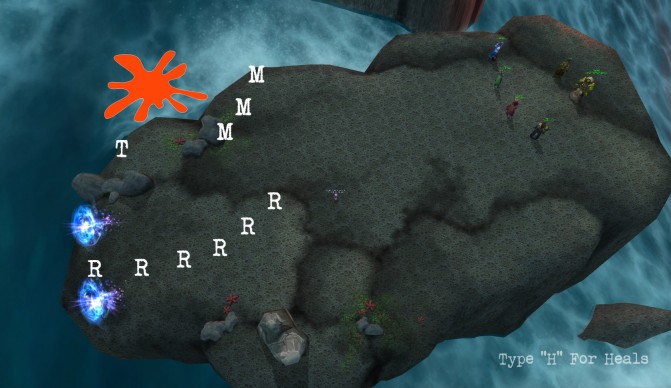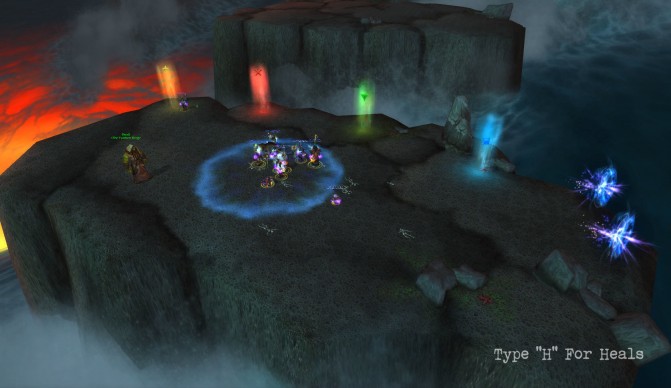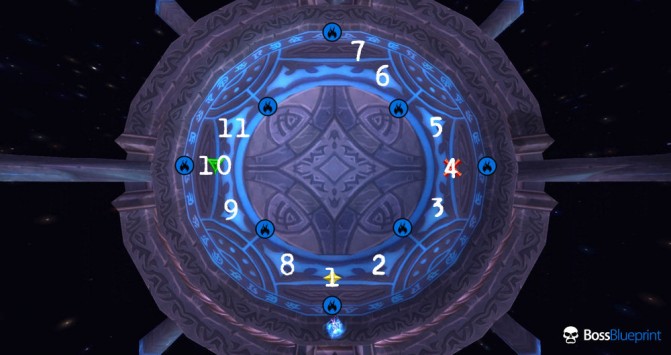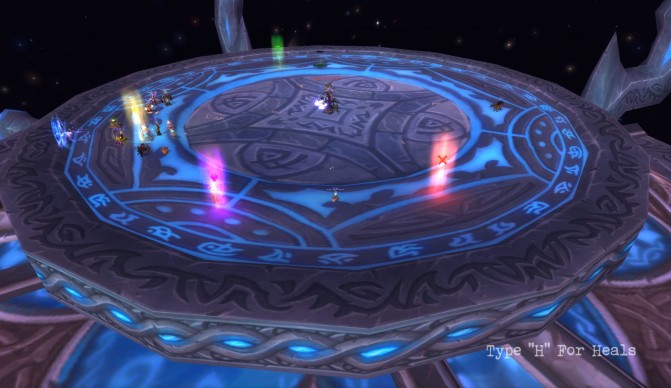
NB: This guide will assume you’ve already read my normal Madness of Deathwing strategy, or otherwise know the details of the fight on normal mode.
Fight Summary
So you’ve killed Spine and now you’re ready for Madness. The good news is that Madness is probably easier than Spine, at least from a technical point of view, and the gear requirements are similar or lower. The bad news is that it’s another 14-minute-plus fight with a long ramp-up time.
There’s not too much different on Heroic, but if you’re used to normal mode you’ll have to tighten up quite a bit to get through it. You can take two tanks but it’s doable with one and you may find you need to go with one tank to beat the berserk timer.
I’ll cover positioning first, then we’ll look at the new mechanic in Phase 1, the Corrupting Parasite, then I’ll cover dealing with Impales before finally talking about each of the phases, including a close look at Phase 2.
Positioning
The first thing you’ll need to tighten up on is your positioning. The Mutated Corruption’s Crush hits very hard, around 80-100k, so you want to minimise the number of people hit by it both to reduce healer mana expenditure and to prevent a second Crush from killing someone. The way to do this is to have the ranged spread out in a curve near the back of the island behind the tank, and the mêlée spread out on the other side:

R are ranged and healers; M are mêlée; T is the tank; and the orange blob is the Mutated Corruption
That’s your baseline positioning while the Mutated Corruption is alive. There will be perturbations in response to mechanics, and I’ll get to those, but you should always aim to return to this general layout.
Phase 1 – Corrupting Parasites
This is the new mechanic on the islands. Twice during the phase, on a fixed timer, Deathwing will cast Corrupting Parasite on a random player. The first comes just as the first Impale is due and the second comes around the time the Regenerative Bloods spawn.
Corrupting Parasite lasts 10 seconds and deals increasing Shadow damage every second while it lasts, starting at 18,000 and topping out at around 80,000 (before resistances), so it’s worth assigning someone to watch this person so they don’t slip through the cracks. When the debuff ends it kicks out a Parasitic Backlash dealing 250,000 Fire damage to everyone within 10 yards and spawns a Corrupting Parasite with around 2.7 million HP. You need to focus on this because at the end of its 10-second Unstable Corruption cast it will explode, dealing damage equal to its remaining HP split across the whole raid.
The short version is that you need the Parasite placed 10 yards away from other people and then you need to kill it, or at least bring it to a safe HP level (around 30% is fine, that’s 80,000 Fire damage per person), before it explodes. Where and how you do that is important though, because efficiency of DPS is a key factor on this fight so you beat the berserk timer on each island and, more importantly, so you have time in hand to take Phase 2 at your own pace.
The first Parasite on each island should be dropped right next to the Mutated Corruption, on the edge of the island, so that you can cleave the Mutated Corruption along with the Parasite. The Parasite is the top priority but adding extra damage to the Mutated Corruption is no bad thing. On the diagram above that’s between the tank and the mêlée so you may need to shuffle around to make sure there’s room, especially if you have more mêlée DPS than I’ve shown there. Also, be careful not to fall off the edge or the Parasite will end up on the wrong island and out of range of DPS. Not that that happened to me, of course…
The second Parasite will spawn as the Mutated Corruption is dying, so this time you want to drop it next to the Arm or Wing Tentacle instead. The Regenerative Bloods will have spawned by this time, so they’ll also be brought over to the Arm or Wing Tentacle and everything should be AoE’d down together for maximum DPS efficiency.
Running through, or standing in, Nozdormu’s Time Zone will slow the tick rate of the debuff, allowing you to extend the time before the Parasite spawns. Basically, you can use this if your Mutated Corruption isn’t quite dying in time to buy time for the tank to bring the Regenerative Bloods over, but if you find you’re waiting for the Parasite to spawn then go around the Time Zone instead. We found the Time Zone handy on the third island, but of course your mileage may vary.
Handling Impale
The Mutated Corruption’s Impale is a big deal on heroic. It deals 840,000 Physical damage as a baseline, and you really can’t afford to take a second one for twice that. Two things need to happen: you need a decent cooldown rotation for any Impales your tank(s) will take, and you need a solution to second Impales.
On the cooldown front, you will need to stack tank cooldowns and healer cooldowns to get through the damage. The first island is easy enough because you have Dream available, so any decent (40% or more) cooldown will do. On the next island you’ll need to stack two 40% or higher cooldowns, such as Shield Wall and Pain Suppression. On the third you’ll not have Alexstrasza’s 20% HP boost so this is a good time to pop a Last Stand-equivalent as well as those cooldowns, and on the last island healers’ 3-minute cooldowns should be up again. Remember that Power Word: Barrier can be used as a 25% cooldown, and if you’re really pushed Spirit Link Totem is a 10% cooldown, which might make the difference.
The Stay of Execution trinket is another 20% cooldown that tanks can use on every island (it applies after any other damage-reducing cooldowns have taken effect, so the damage cap isn’t a problem).
On top of cooldowns, Inspiration/Ancestral Fortitude are good for a further 10% reduction and should be kept up on the tank, and Demoralising Shout/Roar should be kept up on the Mutated Corruption for a 10% Physical damage reduction. Tanks also have their own damage reduction from their tanking stance, presence, form or aura (10%, 14%, 18%, and 10% respectively) which should be added in as well. And don’t forget the raid-wide nerf, Power of the Aspects, which as I write this is at 15%.
Big warning: “cheat death” abilities like Ardent Defender Guardian Spirit do not work on this encounter. AD’s 20% damage reduction does work, but it will not prevent a player’s death.
Just multiply together your cooldowns and damage reductions and check they’ll be enough. For example, here’s our setup for each island, with a Warrior tank:
- 840,000 x 0.85 (Power of the Aspects) x 0.90 (Demo Shout) x 0.90 (Inspiration/Ancestral Fortitude) x 0.90 (Defensive Stance) x 0.60 (Shield Wall) x 0.80 (Stay of Execution) x 0.50 (Dream) = 124,921
- 840,000 x 0.85 (PotA) x 0.90 (Demo Shout) x 0.90 (Insp/AF) x 0.90 (Def Stance) x 0.60 (Shld Wall) x 0.80 (SoEx) x 0.60 (Pain Suppression) = 149,906
- 840,000 x 0.85 (PotA) x 0.90 (Demo Shout) x 0.90 (Insp/AF) x 0.90 (Def Stance) x 0.60 (Shld Wall) x 0.80 (SoEx, not totally effective because the hit exceeds the absorb cap) = 255,324 (Survived by using Last Stand and being topped off)
- 840,000 x 0.85 (PotA) x 0.90 (Demo Shout) x 0.90 (Insp/AF) x 0.90 (Def Stance) x 0.60 (Shld Wall) x 0.80 (SoEx) x 0.60 (Pain Suppression) = 149,906
Now, for the second Impale on an island you can either have a second tank or use a neat little trick to avoid having to worry about the Impale at all. What this relies on is the fact that the Mutated Corruption will Impale anyone it can reach, so you can force it to Impale a specific person by having everyone run out so that they are the only person in range when the cooldown is up. Of course the soaker will also be taking mêlée hits too while before the Impale goes off, so they need to be able to take care of themselves for a short time.
The best choice for this job is a Shadow Priest, because they can use Dispersion to reduce the Impale to a meagre 57,834 Physical damage, and they can do this on every island. If you don’t have a Shadow Priest, you can use a Rogue or Hunter for the same job. Have them step in with Evasion or Deterrence up so they don’t get killed by mêlée swings, and as soon as they get the Impale debuff they should Vanish or Feign Death. This clears the debuff and voilà, you’ve skipped an entire Impale! Just make sure to let the tank get back in first afterwards, or else the keenest mêlée will get killed instead.
Phase 1 Overview
We’ve been through the new abilties in detail, but it’s worth stepping back and looking at them in context.
To begin with, island order. I recommend Ysera, Alexstrasza, Nozdormu and then Kalecgos, as on normal mode. With the extra Crush damage and cooldowns being tied up you need Nozdormu as long as possible, but you still need Kalecgos more to ensure you get everything killed in good time.
Here’s the order of events for a sample island:
- At the start you’ll hit the Arm or Wing Tentacle for a while, then you’ll break off and get into your arcs ready for the Mutated Corruption. Do not bring the Tentacle under 80% HP on the latter two islands until after the Regenerative Bloods have been killed, you don’t want Blistering Tentacles when you’re busy dealing with other things
- Shortly after that the first Corrupting Parasite will be cast, which should be delivered to the spot right in front of the Mutated Corruption
- On the first island you should ignore the Parasite, save DPS and use Dream when it is about to explode
- On subsequent islands it should be killed, cleaving the Mutated Corruption where possible
- A couple of seconds after the Corrupting Parasite cast comes the first Impale. Stick with your cooldown rotation and all will be fine
- You get a ~20 second lull here before the Elementium Bolt is cast, which all DPS should switch to and kill before it lands as usual
- Shortly after the Bolt is dealt with the second Impale comes out. You’ve got a plan for this, so execute it
- Immediately after the second Impale the Regenerative Bloods will spawn. These should be brought and misdirected to the tank and held while the Mutated Corruption dies
- A few seconds after the Bloods spawn the second Parasite gets cast. This should be dropped over by the Arm or Wing tentacle
- Once the Parasite is dropped and the Mutated Corruption is dead, the tank should drag the Regenerative Bloods over to the Arm or Wing Tentacle and the whole lot should be AoE’d down.
- At this point the fight is the same as normal mode. Kill the Arm or Wing Tentacle, and any other tentacles that might spawn
On the fourth island you should handle the Elementium Bolt as usual, running away from it, popping PW:B if you use it and Tranqs and Divine Hymns if you have them. However to help prevent half the raid getting Crushed while clumped in the bubble you can have people with personal cooldowns stand outside the bubble instead. Your healers will thank you!
Each of the islands proceeds along much the same lines, although the general level of damage increases as you go along. There’s a lot to take in but there’s also a clear rhythm to the encounter which you’ll soon figure out, and it’ll end up feeling a lot less complicated than it looks.
Phase 2
Hopefully you’ve completed Phase 1 in good time, because Phase 2 is as much about control as raw output, although there’s a hefty burst DPS requirement too.
The Elementium Fragments are still in play, as are the Elementium Terrors. Handle them as you always would: kill them ASAP, use Dream if you get targeted by Shrapnel and tank the Terrors in the Time Zone to slow the rate at which they can stack Tetanus. On heroic 7-8 stacks is quite enough, needing external cooldowns and intensive healing to survive.
The new aspect is the Congealing Blood. These start to spawn at 15.9%, 10.9% and 5.9% from approximately the locations shown on the screenshot below, and slime their way towards Deathwing. If they reach him they heal him for 1% each. Even one getting through could spell disaster though, because if you take Deathwing above a trigger point he’ll spawn more Congealing Bloods when you DPS him down past it again.

Congealing Blood approximate spawn locations
The Bloods cannot be stunned, rooted or knocked back, so slows and AoE damage are vital here. Be careful not to overwrite slowing effects. We chose to have our rogue use Fan of Knives with Crippling Poison on the Bloods to keep them slowed, and we had a DK with Chillblains helping out as well while everyone else focused on killing them.
The key to this phase is control and not trying to do too much at once. If your tank can drop the Tetanus debuff easily (DK, Paladin) then go ahead and tank the Terrors with the Bloods and AOE everything together. However at 15% this isn’t necessary any more, you have time to kill each thing in turn, and the encounter feels a lot more manageable if you take your time.
Here’s the sequence we went for:
- DPS Deathwing to 17% (not much lower so that DoTs and spellweave (the AoE bonus you get from Kalecgos) don’t take him under prematurely)
- Kill the first Fragments
- Kill the first Terrors
- Push Deathwing under 15.9%
- Kill the Congealing Bloods
- Push Deathwing under 10.9%
- Kill the Congealing Bloods
- Kill the second Fragments
- Kill the second Terrors
- Push Deathwing under 5.9%
- Kill the Congealing Bloods
- Kill Deathwing, ignoring any Fragments that might spawn at the end
The timing was pretty tight on getting the second Bloods killed before the second set of Fragments spawned but we ended the encounter with 30-40 seconds in hand, so there was time for us to have waited if necessary to survive.
Spec and Glyphs
There’s a bit of everything to deal with, so picking a focused spec is a little tricky. I stuck with the Atonement spec because with the fixed range on Atonement you can do a good job of smart-healing people from Crushes. Plus Atonement benefits from the double damage on the Arm and Wing Tentacles for the third minute on each island making it competitive HPS at a very low cost. Archangel is also great to pop when the Blistering Tentacles spawn for a bit of an extra boost to your raid healing, and for healing up after the Elementium Bolt on the fourth island.
Although PW:B gets used I found that people weren’t standing in it enough to make the glyph worthwhile. I ended up settling for PW:S, PoH and Penance as Prime glyphs. Penance is good as a quick heal on Crushed people, for keeping Inspiration on the tank or for keeping up my Heart of Unliving stacks, and I was casting PW:S frequently for Rapture procs.
For Majors I swapped Dispel for Glyph of Prayer of Mending, since there’s nothing to Dispel, and because PoM should be bouncing for most of the fight.
And once again, get the Glyph of Fading. You’ll need it every time the Regenerative Bloods come up, and every little helps.
Cooldown Usage
Your tank cooldowns will be almost entirely dictated by the fight and your strategy. Because you’ll typically spend up to 2 and a half minutes per island you can’t guarantee that your 3-minute cooldowns will be available for the same point on every island, so play it safe and plan to have them up every other plate. Your PW:B will be needed on the fourth island, so avoid using it on the third, although there may just be enough time between the first impale on the third and the Bolt on the fourth, it’ll depend on your raid’s DPS and speed.
In Phase 2, Pain Suppression should be used on the Terror tank when their Tetanus stacks reach 6 or above, followed by spam-healing until the debuff fades. You can either use PW:B on the raid to mitigate the damage later on or on the tank again for the next set of Terrors, depending on the other cooldowns used. Bear in mind that if you can get a few raid members to stand in it Spirit Link Totem can be a lifesaver for a Terror tank, giving them access to a much larger effective health pool, so you may wish to use your PW:B on the raid instead.
Leap of Faith isn’t a terribly useful ability on this fight if the strategy is being executed correctly. You can extract people who are slow to move away from the Mutated Corruption before an Impale, but otherwise no one should have trouble getting to where they need to be.
Timing Shadowfiend and Hymn of Hope is tricky here. Ideally you’d get them in three times, given a 14-minute-ish duration, but it’s quite possible you just won’t need them on the first island. I’d recommend using them early anyway, you might help someone with the Hymn of Hope and the DPS from the Shadowfiend can help get the Mutated Corruption out of the way a fraction quicker. And even if most of the mana is wasted, it’s better than not casting them at all.
If you cast them after you’ve healed up the first Parasite explosion you’ll have a mana deficit to recover, and then you can cast them together on the third island and on Deathwing’s head during Phase 2.
Other Tips
Keep Fade handy for the Regenerative Blood spawn, especially if you’re 1-tanking the fight. Fade early too to avoid getting any DoT stacks and keep them going where they’re supposed to.
Rapture is so important for maintaining your mana on this encounter. If you’ve got a bit sloppy up to now, it’s time to get back on the straight and narrow. Remember, even after the Mutated Corruption dies there’s going to be enough raid damage to burst the bubble pretty reliably so cast it on anyone when the Rapture ICD expires and enjoy vastly improved mana regen.
That same raid damage also means PoM will almost never fail to use all of its charges, making it quite mana-efficient and a good use of a GCD. Keep it going as much as is practical, especially once the Arm or Wing Tentacles are below 70%.
On the first and second set of Congealing Bloods in Phase 2 you can help with some Mind Searing. Remember to pick a mêlée DPS to sear off instead of tab-targeting a Blood, or it’ll get interrupted every time the Blood dies.
Finally, not a Discipline tip but a good one anyway: if you have trouble with the portal at the entrance sometimes sending you to Wyrmrest Temple instead of the Maelstrom, go up onto the Skyfire gunship and talk to Sky Captain Swayze to set it in motion, then use the portal in the bridge to get to the Maelstrom. After that, the entrance portal will go to the right place (until the instance resets).
Good luck, and have fun! Comments, questions and additions appreciated.
Possibly Related Posts:













